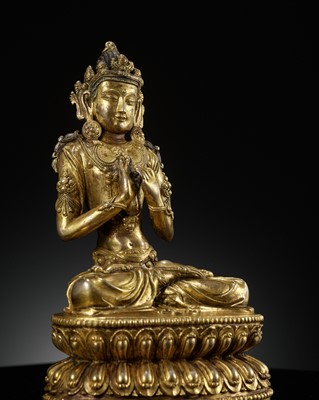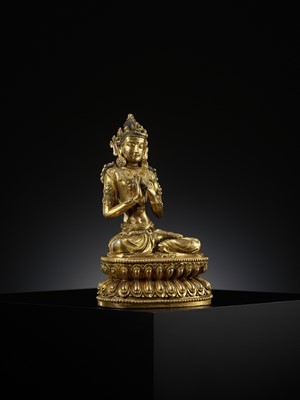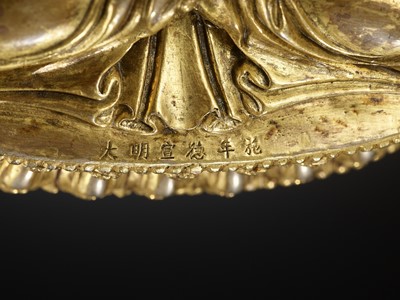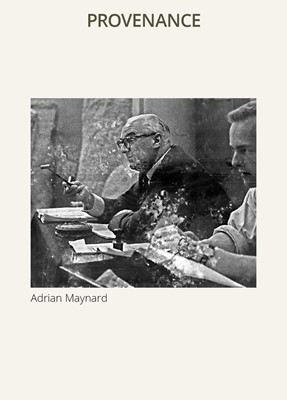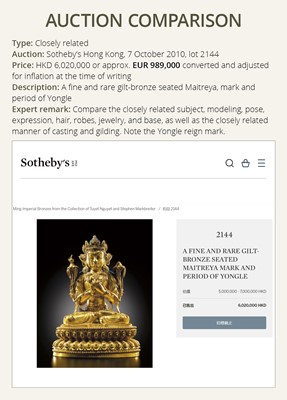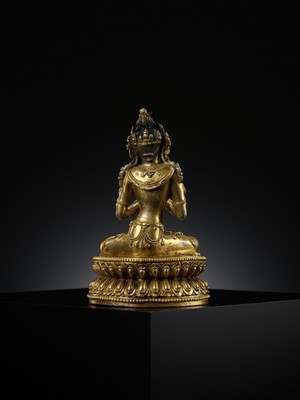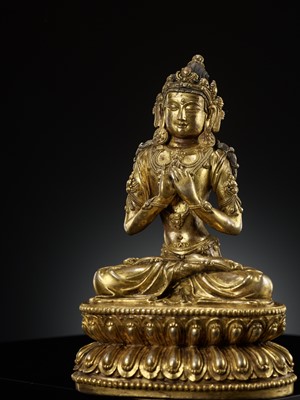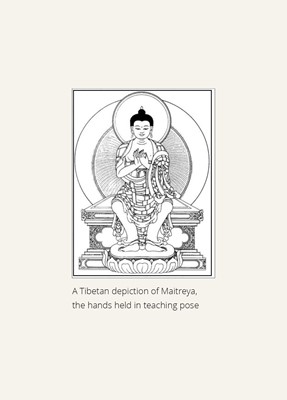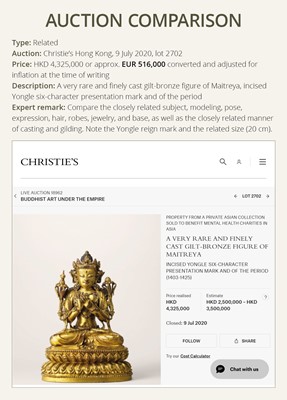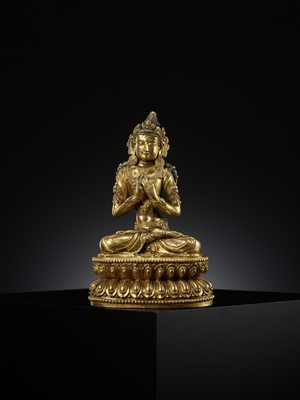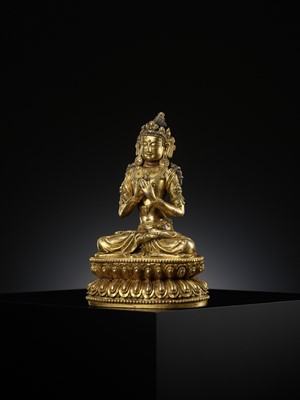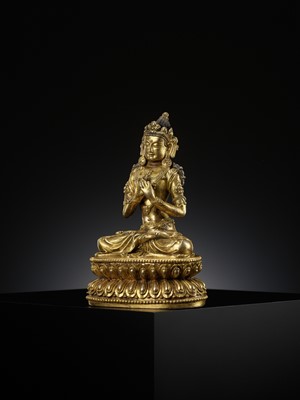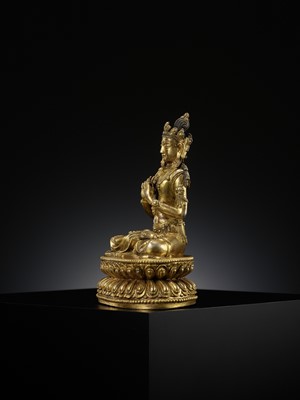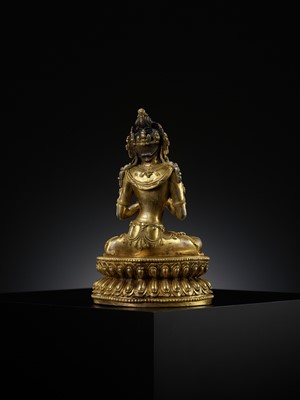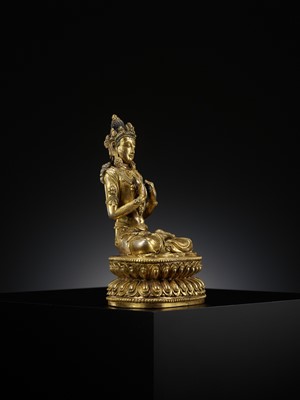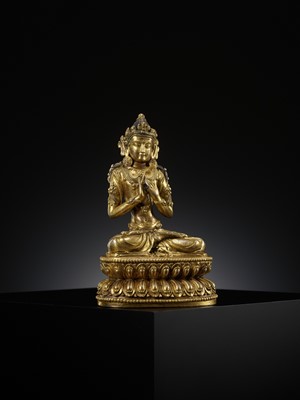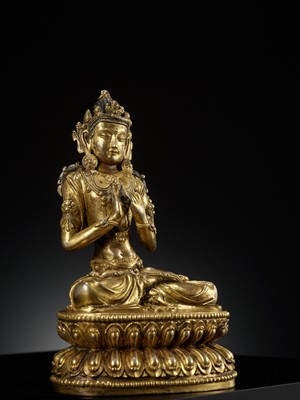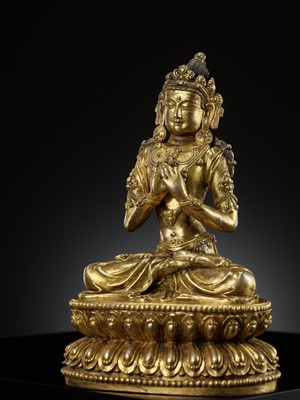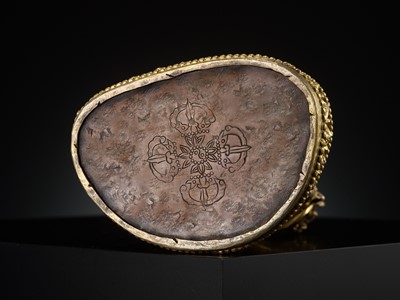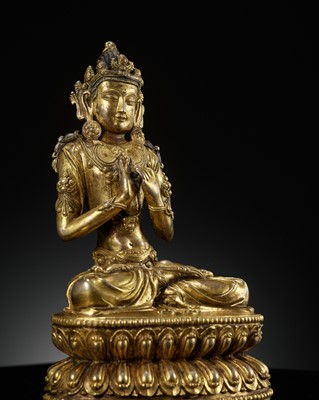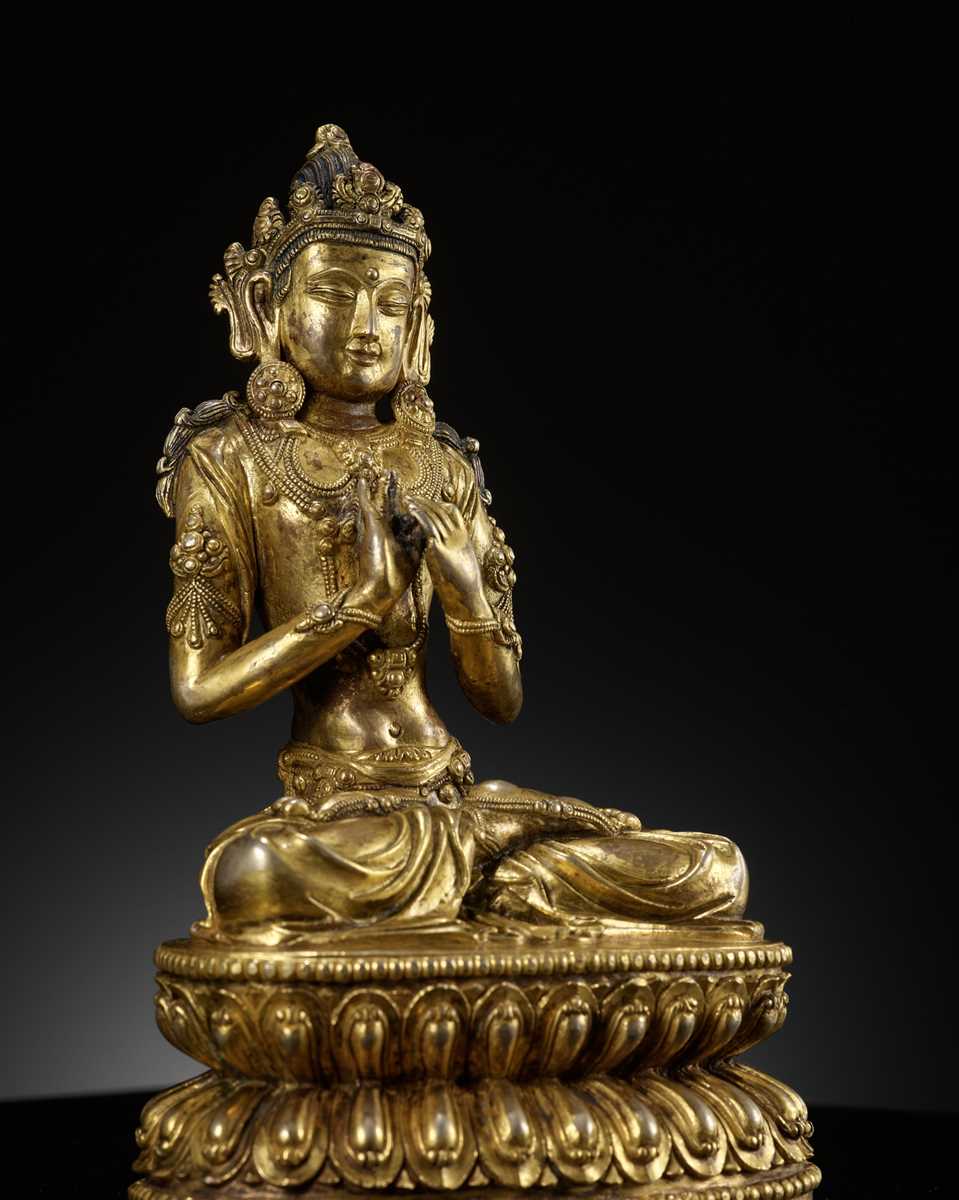11th Oct, 2023 11:00
THREE-DAY AUCTION - Fine Chinese Art / 中國藝術集珍 / Buddhism & Hinduism
180
MAITREYA IN THE TUSHITA HEAVEN, AN EXTREMELY RARE GILT-BRONZE FIGURE, XUANDE INCISED SIX-CHARACTER MARK AND OF THE PERIOD, CHINA, 1425-1435
明代宣德六字款罕見銅鎏金兜率天彌勒坐像
Sold for €169,000
including Buyer's Premium
Expert’s note: Maitreya is visualized here in his manifestation as a princely bodhisattva, teaching in the Tushita heaven, thus with his hands held in dharmachakra mudra, the teaching pose (turning the wheel of the second law), after which Maitreya will leave the Tushita heaven and come upon earth to 'establish the lost truths in all their purity.' Maitreya’s face is imbued with compassion, the essential quality of the bodhisattva, with a downward gaze and gentle smile. Maitreya is the only Boddhisattva who is popular among all sects of Buddhism, such as the Mahayana, the Hinayana, and the Vajrayana, and he is often shown with his long hair hanging over his shoulders, such as in the present portrayal.
Superbly cast, the bodhisattva seated in vajraparyankasana on a double-lotus base with beaded edges, his hands held in dharmachakra mudra, wearing a dhoti with exquisitely carved folds gathered at the waist and fastened by a beaded girdle and a scarf around the bare shoulders flowing over the arms, revealing the chest adorned with beaded pendent jewelry. The upper surface of the base is engraved with a six-character mark da Ming Xuande nian shi and of the period.
Provenance: Spink & Son, London, United Kingdom, c. 1966. Adrian Maynard, London, United Kingdom, acquired from the above and thence by descent within the family. A noted Hungarian collector, acquired from the above after 2015. Adrian Maynard joined Spink & Sons in 1947, where he was appointed Director from 1962 and eventually Deputy Chairman until his retirement in 1984. He was a man of enormous drive and undoubtedly the most flamboyant character to take charge of the Asian art department, which he took to the height of its success. Maynard believed firmly that "a dealer, whose fortune and good name depends on knowing what to buy, has a much greater responsibility to be right about the objects that come into his hands than, say, an academic, who never handles large sums of money.”
Condition: Good condition with expected old wear. Minimal casting flaws, few minuscule nicks, and remnants of old pigment and varnish. The base retains the original sealing.
Weight: 1,520 g
Dimensions: Height 18.2 cm
Please click here to read the full description
Maitreya is richly adorned with further fine bodhisattva jewelry including a foliate crown framing the forehead and tied with billowing sashes at the ears, circular studded earrings, and beaded bracelets, armbands, anklets, and foot adornments. The serene face with a benevolent expression, the eyes with heavy sinuous lids below gently arched brows centered by a raised circular urna. The smiling mouth with full bow-shaped lips, the neatly incised hair drawn up in a knotted jatamakuta topped by a cintamani jewel and falling elegantly in tresses to the shoulders. The base is sealed with a plate, neatly incised with a visvavajra emblem.
During the Yuan Dynasty in the 13th and 14th centuries, the authority of Mongol rulers had become closely associated with Tibetan Buddhist or Lamaist rituals. At the beginning of the 15th century, the Buddhist fervor of the Ming court encouraged a cultural exchange between Tibet and China through Imperial patronage. Bronze sculptures in the Tibeto-Chinese style were first produced during the reign of Emperor Yongle (1403-1424) and are highly distinguished for their unsurpassed craftsmanship, overall refinement, and gracefulness.
Emperor Yongle (1403-1425), a devout Buddhist himself, bestowed generous patronage to Buddhist monasteries and artistic ateliers, fostering the production of artworks depicting Tibetan Buddhist deities and imagery in a highly refined style, executed with the highest level of technical mastery. Gilt bronzes were commissioned from the Imperial workshops in Beijing for personal religious practices and as gifts for the many Tibetan emissaries invited to the court.
Fewer examples bear the reign mark of Xuande (1425-1435) and the present lot is closely related to its Yongle predecessors, both stylistically and technically. The present figure was made at the Imperial ateliers in Beijing, probably during the early phase of the Xuande period, by the same craftsmen who continued their work from the Yongle period.
Literature comparison:
Very few other figures of Maitreya from this group of reign-marked, early-15th-century gilt-bronzes have been published. Compare a related Yongle-marked gilt-bronze figure of Maitreya illustrated in Ulrich von Schroeder, Buddhist Sculptures in Tibet, Hong Kong, 2001, vol. II, pl. 343F. Compare a related Yongle-marked gilt-bronze figure of Maitreya illustrated in The Chang Foundation, Buddhist Images in Gilt Metal, Taipei, 1993, cat. 22. Compare a related Yongle-marked gilt-bronze figure of Maitreya illustrated in Ulrich von Schroeder, Indo-Tibetan Bronzes, Hong Kong 1981, 147E (later restored without a vase and now in the Aschmann collection). For a related Xuande-marked gilt-bronze figure of Vajrasattva, see The Complete Collection of Treasures of the Palace Museum, Buddhist Statues of Tibet, p. 230, no. 219.
Auction result comparison:
Type: Related
Auction: Christie’s Hong Kong, 9 July 2020, lot 2702
Price: HKD 4,325,000 or approx. EUR 516,000 converted and adjusted for inflation at the time of writing
Description: A very rare and finely cast gilt-bronze figure of Maitreya, incised Yongle six-character presentation mark and of the period
Expert remark: Compare the closely related subject, modeling, pose, expression, hair, robes, jewelry, and base, as well as the closely related manner of casting and gilding. Note the Yongle reign mark and the related size (20 cm).
Auction result comparison:
Type: Closely related
Auction: Sotheby’s Hong Kong, 7 October 2010, lot 2144
Price: HKD 6,020,000 or approx. EUR 989,000 converted and adjusted for inflation at the time of writing
Description: A fine and rare gilt-bronze seated Maitreya, mark and period of Yongle
Expert remark: Compare the closely related subject, modeling, pose, expression, hair, robes, jewelry, and base, as well as the closely related manner of casting and gilding. Note the Yongle reign mark.
点此阅读中文翻译 (Chinese Translation)
明代宣德六字款罕見銅鎏金兜率天彌勒坐像
彌勒佛結跏趺坐於雙層蓮花座上,雙手結法輪印,底座上表面刻有“大明宣德年施”六字款。彌勒頭頂挽高髮髻,寶珠頂嚴,戴雕飾精美的五葉寶冠,耳戴圓形團花大耳鐺垂落肩頭。面形方正,垂眸含笑,表情沉靜。上身飾項圈和長鏈,項圈下綴U字形連珠式瓔珞,下身著長裙,腰間束寶帶,連珠式瓔珞裝飾,手和足部有釧躅裝飾。裙子與帔帛採取寫實手法表現,衣紋流暢優美,生動表現出絲織物本有的質感。底座密封,上有雙金剛杵印。
專家注釋:彌勒佛在兜率天說法,雙手結法輪印。之後彌勒就會離開兜率天下降成佛。在地球上“建立失去的真理的純潔性”。彌勒佛的面容充滿慈悲,這是菩薩的本質品質,目光向下,笑容溫和。 彌勒菩薩是唯一一位深受大乘、小乘、金剛乘等佛教各教派歡迎的菩薩,常以長髮披肩,如本畫所示。
來源:英國倫敦Spink & Son藝廊,約在 1966年;倫敦Adrian Maynard購於上述藝廊,在同一家族保存;一位知名匈牙利藏家2015年之後購於上述收藏。Adrian Maynard 1947年加入Spink & Sons,他1962 年被任命為董事,最終成爲副主席,直至1984 年退休。他是一個充滿幹勁的人,無疑是負責亞洲藝術部門最耀眼的人物,他使該部門取得了巨大的成功。Maynard堅信,“一個商人的財富和名聲取決於知道該買什麼,他比一個從不處理大筆資金的學者更有責任正確對待手中的物品。 ”
品相:狀況良好,有磨損,極小的鑄造缺陷,有微小的刻痕,以及顏料和清漆的餘留。底座密封。
重量:1,520 克
尺寸:高 18.2 厘米
十三至十四世紀的元朝時期,蒙古統治者的權威與藏傳佛教或喇嘛教的儀式密切相關。十五世紀初,明朝宮廷對佛教的熱愛更加促進了西藏和中國之間的文化交流。漢藏風格的造像始創於永樂年間(1403-1424年),工藝精湛、雍容華貴。
永樂皇帝(1403-1425)本身就是一位虔誠的佛教徒,他對佛教寺院和造像工藝給予慷慨的支持,當時技術水平極高。御製鎏金銅像器用於宗教儀式,也作為禮物送給許多受邀到宮廷的西藏使者。
帶有宣德(1425-1435)年號的拍品較少,本拍品在風格和技術上都與永樂風格密切相關。此尊造像為御製,年代可能是宣德初期,出自永樂時期的工匠之手。
文獻比較:
十五世紀初有款識的鎏金銅彌勒像較少見。比較一件相近的永樂款鎏金銅彌勒佛像,見 Ulrich von Schroeder,《Buddhist Sculptures in Tibet》,香港,2001 年,卷二,圖343F。比較一件相近的永樂款鎏金銅彌勒佛像,見張氏基金會,《金銅佛造像》,台北,1993 年,編號22。比較一件相近的永樂款鎏金銅彌勒佛像,Ulrich von Schroeder, 《Indo-Tibetan Bronzes》,香港,1981年,147E。一件相近的宣德款鎏金金剛薩埵像,見《故宮博物院藏文物珍品全集》,《西藏佛像》,頁230,編號219。
拍賣結果比較:
形制:相近
拍賣:香港佳士得,2020年7月9日,lot 2702
價格:HKD 4,325,000(相當於今日EUR 516,000)
描述:明永樂鎏金銅彌勒菩薩坐像「大明永樂年施」刻款
專家評論:比較非常相近的主題、模款、姿勢、表情、髮型、長袍、珠寶和蓮座,以及非常相近的鑄造和鎏金風格。請注意永樂款識和相近的尺寸 (20 釐米)。
拍賣結果比較:
形制:非常相近
拍賣:香港蘇富比,2010年10月7日,lot 2144
價格:HKD 6,020,000(相當於今日EUR 989,000)
描述:永樂款及年代鎏金銅彌勒佛像
專家評論:比較非常相近的主題、模款、姿勢、表情、髮型、長袍、珠寶和蓮座,以及非常相近的鑄造和鎏金風格。請注意永樂款識。
Expert’s note: Maitreya is visualized here in his manifestation as a princely bodhisattva, teaching in the Tushita heaven, thus with his hands held in dharmachakra mudra, the teaching pose (turning the wheel of the second law), after which Maitreya will leave the Tushita heaven and come upon earth to 'establish the lost truths in all their purity.' Maitreya’s face is imbued with compassion, the essential quality of the bodhisattva, with a downward gaze and gentle smile. Maitreya is the only Boddhisattva who is popular among all sects of Buddhism, such as the Mahayana, the Hinayana, and the Vajrayana, and he is often shown with his long hair hanging over his shoulders, such as in the present portrayal.
Superbly cast, the bodhisattva seated in vajraparyankasana on a double-lotus base with beaded edges, his hands held in dharmachakra mudra, wearing a dhoti with exquisitely carved folds gathered at the waist and fastened by a beaded girdle and a scarf around the bare shoulders flowing over the arms, revealing the chest adorned with beaded pendent jewelry. The upper surface of the base is engraved with a six-character mark da Ming Xuande nian shi and of the period.
Provenance: Spink & Son, London, United Kingdom, c. 1966. Adrian Maynard, London, United Kingdom, acquired from the above and thence by descent within the family. A noted Hungarian collector, acquired from the above after 2015. Adrian Maynard joined Spink & Sons in 1947, where he was appointed Director from 1962 and eventually Deputy Chairman until his retirement in 1984. He was a man of enormous drive and undoubtedly the most flamboyant character to take charge of the Asian art department, which he took to the height of its success. Maynard believed firmly that "a dealer, whose fortune and good name depends on knowing what to buy, has a much greater responsibility to be right about the objects that come into his hands than, say, an academic, who never handles large sums of money.”
Condition: Good condition with expected old wear. Minimal casting flaws, few minuscule nicks, and remnants of old pigment and varnish. The base retains the original sealing.
Weight: 1,520 g
Dimensions: Height 18.2 cm
Please click here to read the full description
Maitreya is richly adorned with further fine bodhisattva jewelry including a foliate crown framing the forehead and tied with billowing sashes at the ears, circular studded earrings, and beaded bracelets, armbands, anklets, and foot adornments. The serene face with a benevolent expression, the eyes with heavy sinuous lids below gently arched brows centered by a raised circular urna. The smiling mouth with full bow-shaped lips, the neatly incised hair drawn up in a knotted jatamakuta topped by a cintamani jewel and falling elegantly in tresses to the shoulders. The base is sealed with a plate, neatly incised with a visvavajra emblem.
During the Yuan Dynasty in the 13th and 14th centuries, the authority of Mongol rulers had become closely associated with Tibetan Buddhist or Lamaist rituals. At the beginning of the 15th century, the Buddhist fervor of the Ming court encouraged a cultural exchange between Tibet and China through Imperial patronage. Bronze sculptures in the Tibeto-Chinese style were first produced during the reign of Emperor Yongle (1403-1424) and are highly distinguished for their unsurpassed craftsmanship, overall refinement, and gracefulness.
Emperor Yongle (1403-1425), a devout Buddhist himself, bestowed generous patronage to Buddhist monasteries and artistic ateliers, fostering the production of artworks depicting Tibetan Buddhist deities and imagery in a highly refined style, executed with the highest level of technical mastery. Gilt bronzes were commissioned from the Imperial workshops in Beijing for personal religious practices and as gifts for the many Tibetan emissaries invited to the court.
Fewer examples bear the reign mark of Xuande (1425-1435) and the present lot is closely related to its Yongle predecessors, both stylistically and technically. The present figure was made at the Imperial ateliers in Beijing, probably during the early phase of the Xuande period, by the same craftsmen who continued their work from the Yongle period.
Literature comparison:
Very few other figures of Maitreya from this group of reign-marked, early-15th-century gilt-bronzes have been published. Compare a related Yongle-marked gilt-bronze figure of Maitreya illustrated in Ulrich von Schroeder, Buddhist Sculptures in Tibet, Hong Kong, 2001, vol. II, pl. 343F. Compare a related Yongle-marked gilt-bronze figure of Maitreya illustrated in The Chang Foundation, Buddhist Images in Gilt Metal, Taipei, 1993, cat. 22. Compare a related Yongle-marked gilt-bronze figure of Maitreya illustrated in Ulrich von Schroeder, Indo-Tibetan Bronzes, Hong Kong 1981, 147E (later restored without a vase and now in the Aschmann collection). For a related Xuande-marked gilt-bronze figure of Vajrasattva, see The Complete Collection of Treasures of the Palace Museum, Buddhist Statues of Tibet, p. 230, no. 219.
Auction result comparison:
Type: Related
Auction: Christie’s Hong Kong, 9 July 2020, lot 2702
Price: HKD 4,325,000 or approx. EUR 516,000 converted and adjusted for inflation at the time of writing
Description: A very rare and finely cast gilt-bronze figure of Maitreya, incised Yongle six-character presentation mark and of the period
Expert remark: Compare the closely related subject, modeling, pose, expression, hair, robes, jewelry, and base, as well as the closely related manner of casting and gilding. Note the Yongle reign mark and the related size (20 cm).
Auction result comparison:
Type: Closely related
Auction: Sotheby’s Hong Kong, 7 October 2010, lot 2144
Price: HKD 6,020,000 or approx. EUR 989,000 converted and adjusted for inflation at the time of writing
Description: A fine and rare gilt-bronze seated Maitreya, mark and period of Yongle
Expert remark: Compare the closely related subject, modeling, pose, expression, hair, robes, jewelry, and base, as well as the closely related manner of casting and gilding. Note the Yongle reign mark.
点此阅读中文翻译 (Chinese Translation)
明代宣德六字款罕見銅鎏金兜率天彌勒坐像
彌勒佛結跏趺坐於雙層蓮花座上,雙手結法輪印,底座上表面刻有“大明宣德年施”六字款。彌勒頭頂挽高髮髻,寶珠頂嚴,戴雕飾精美的五葉寶冠,耳戴圓形團花大耳鐺垂落肩頭。面形方正,垂眸含笑,表情沉靜。上身飾項圈和長鏈,項圈下綴U字形連珠式瓔珞,下身著長裙,腰間束寶帶,連珠式瓔珞裝飾,手和足部有釧躅裝飾。裙子與帔帛採取寫實手法表現,衣紋流暢優美,生動表現出絲織物本有的質感。底座密封,上有雙金剛杵印。
專家注釋:彌勒佛在兜率天說法,雙手結法輪印。之後彌勒就會離開兜率天下降成佛。在地球上“建立失去的真理的純潔性”。彌勒佛的面容充滿慈悲,這是菩薩的本質品質,目光向下,笑容溫和。 彌勒菩薩是唯一一位深受大乘、小乘、金剛乘等佛教各教派歡迎的菩薩,常以長髮披肩,如本畫所示。
來源:英國倫敦Spink & Son藝廊,約在 1966年;倫敦Adrian Maynard購於上述藝廊,在同一家族保存;一位知名匈牙利藏家2015年之後購於上述收藏。Adrian Maynard 1947年加入Spink & Sons,他1962 年被任命為董事,最終成爲副主席,直至1984 年退休。他是一個充滿幹勁的人,無疑是負責亞洲藝術部門最耀眼的人物,他使該部門取得了巨大的成功。Maynard堅信,“一個商人的財富和名聲取決於知道該買什麼,他比一個從不處理大筆資金的學者更有責任正確對待手中的物品。 ”
品相:狀況良好,有磨損,極小的鑄造缺陷,有微小的刻痕,以及顏料和清漆的餘留。底座密封。
重量:1,520 克
尺寸:高 18.2 厘米
十三至十四世紀的元朝時期,蒙古統治者的權威與藏傳佛教或喇嘛教的儀式密切相關。十五世紀初,明朝宮廷對佛教的熱愛更加促進了西藏和中國之間的文化交流。漢藏風格的造像始創於永樂年間(1403-1424年),工藝精湛、雍容華貴。
永樂皇帝(1403-1425)本身就是一位虔誠的佛教徒,他對佛教寺院和造像工藝給予慷慨的支持,當時技術水平極高。御製鎏金銅像器用於宗教儀式,也作為禮物送給許多受邀到宮廷的西藏使者。
帶有宣德(1425-1435)年號的拍品較少,本拍品在風格和技術上都與永樂風格密切相關。此尊造像為御製,年代可能是宣德初期,出自永樂時期的工匠之手。
文獻比較:
十五世紀初有款識的鎏金銅彌勒像較少見。比較一件相近的永樂款鎏金銅彌勒佛像,見 Ulrich von Schroeder,《Buddhist Sculptures in Tibet》,香港,2001 年,卷二,圖343F。比較一件相近的永樂款鎏金銅彌勒佛像,見張氏基金會,《金銅佛造像》,台北,1993 年,編號22。比較一件相近的永樂款鎏金銅彌勒佛像,Ulrich von Schroeder, 《Indo-Tibetan Bronzes》,香港,1981年,147E。一件相近的宣德款鎏金金剛薩埵像,見《故宮博物院藏文物珍品全集》,《西藏佛像》,頁230,編號219。
拍賣結果比較:
形制:相近
拍賣:香港佳士得,2020年7月9日,lot 2702
價格:HKD 4,325,000(相當於今日EUR 516,000)
描述:明永樂鎏金銅彌勒菩薩坐像「大明永樂年施」刻款
專家評論:比較非常相近的主題、模款、姿勢、表情、髮型、長袍、珠寶和蓮座,以及非常相近的鑄造和鎏金風格。請注意永樂款識和相近的尺寸 (20 釐米)。
拍賣結果比較:
形制:非常相近
拍賣:香港蘇富比,2010年10月7日,lot 2144
價格:HKD 6,020,000(相當於今日EUR 989,000)
描述:永樂款及年代鎏金銅彌勒佛像
專家評論:比較非常相近的主題、模款、姿勢、表情、髮型、長袍、珠寶和蓮座,以及非常相近的鑄造和鎏金風格。請注意永樂款識。
Zacke Live Online Bidding
Our online bidding platform makes it easier than ever to bid in our auctions! When you bid through our website, you can take advantage of our premium buyer's terms without incurring any additional online bidding surcharges.
To bid live online, you'll need to create an online account. Once your account is created and your identity is verified, you can register to bid in an auction up to 12 hours before the auction begins.
Intended Spend and Bid Limits
When you register to bid in an online auction, you will need to share your intended maximum spending budget for the auction. We will then review your intended spend and set a bid limit for you. Once you have pre-registered for a live online auction, you can see your intended spend and bid limit by going to 'Account Settings' and clicking on 'Live Bidding Registrations'.
Your bid limit will be the maximum amount you can bid during the auction. Your bid limit is for the hammer price and is not affected by the buyer’s premium and VAT. For example, if you have a bid limit of €1,000 and place two winning bids for €300 and €200, then you will only be able to bid €500 for the rest of the auction. If you try to place a bid that is higher than €500, you will not be able to do so.
Online Absentee and Telephone Bids
You can now leave absentee and telephone bids on our website!
Absentee Bidding
Once you've created an account and your identity is verified, you can leave your absentee bid directly on the lot page. We will contact you when your bids have been confirmed.
Telephone Bidding
Once you've created an account and your identity is verified, you can leave telephone bids online. We will contact you when your bids have been confirmed.
Classic Absentee and Telephone Bidding Form
You can still submit absentee and telephone bids by email or fax if you prefer. Simply fill out the Absentee Bidding/Telephone bidding form and return it to us by email at office@zacke.at or by fax at +43 (1) 532 04 52 20. You can download the PDF from our Upcoming Auctions page.
How-To Guides
How to Create Your Personal Zacke Account
How to Register to Bid on Zacke Live
How to Leave Absentee Bids Online
How to Leave Telephone Bids Online
中文版本的操作指南
创建新账号
注册Zacke Live在线直播竞拍(免平台费)
缺席投标和电话投标
Third-Party Bidding
We partner with best-in-class third-party partners to make it easy for you to bid online in the channel of your choice. Please note that if you bid with one of our third-party online partners, then there will be a live bidding surcharge on top of your final purchase price. You can find all of our fees here. Here's a full list of our third-party partners:
- 51 Bid Live
- EpaiLive
- ArtFoxLive
- Invaluable
- LiveAuctioneers
- the-saleroom
- lot-tissimo
- Drouot
Please note that we place different auctions on different platforms. For example, in general, we only place Chinese art auctions on 51 Bid Live.
Bidding in Person
You must register to bid in person and will be assigned a paddle at the auction. Please contact us at office@zacke.at or +43 (1) 532 04 52 for the latest local health and safety guidelines.
